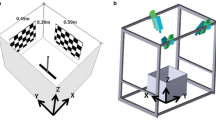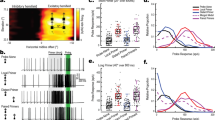Abstract
The capture of flying insects by foraging dragonflies is a highly accurate, visually guided behavior. Rather than simply aiming at the prey’s position, the dragonfly aims at a point in front of the prey, so that the prey is intercepted with a relatively straight flight trajectory. To better understand the neural mechanisms underlying this behavior, we used high-speed video to quantify the head and body orientation of dragonflies (female Erythemis simplicicollis flying in an outdoor flight cage) relative to an artificial prey object before and during pursuit. The results of our frame-by-frame analysis showed that during prey pursuit, the dragonfly adjusts its head orientation to maintain the image of the prey centered on the “crosshairs” formed by the visual midline and the dorsal fovea, a high acuity streak that crosses midline at right angles about 60° above the horizon. The visual response latencies to drifting of the prey image are remarkably short, ca. 25 ms for the head and 30 ms for the wing responses. Our results imply that the control of the prey-interception flight must include a neural pathway that takes head position into account.







Similar content being viewed by others
Explore related subjects
Discover the latest articles and news from researchers in related subjects, suggested using machine learning.Abbreviations
- TSDNs:
-
Target selective descending neurons
References
Adelman TL, Bialek W, Olberg RM (2003) The information content of receptive fields. Neuron 40:823-833-1500
Baird JM, May ML (1997) Foraging behavior of Pachydiplax longipennis (Odonata: Libellulidae). J Insect Behavior 10: 655–678
Collett TS, Land MF (1978) How hoverflies compute interception courses. J Comp Physiol A 125: 191–204
Frye MA, Olberg RM (1995) Visual receptive field properties of feature detecting neurons in the dragonfly. J Comp Physiol A 177: 569–576
Gilbert C, Strausfeld NJ (1991) The functional organization of male-specific visual neurons in flies. J Comp Physiol 169:395–411
Gilbert C, Gronenberg W, Strausfeld NJ (1995) Oculomotor control in Calliphorid flies: head movements during activation and inhibition of neck motor neurons corroborate neuroanatomical predictions. J Comp Neurol 361:285–297
Horridge GA (1978) The separation of visual axes in apposition compound eyes. Phil Trans R Soc Lond B 285:1–59
Horridge A (2005) The spatial resolutions of the apposition compound eye and its neuro-sensory feature detectors: observation versus theory. J Insect Physiol 51:243–266
Kirmse W, Lässig P (1971) Strukturanalogie zwischen dem system der horizontalen blickbewegungen der augen beim menschen und dem system der blickbewegungen des kopfes bei insekten mit fixationsreaktionen. Biol Zbl 90:175–193
Labhart T, Nilsson D-E (1995) The dorsal eye of the dragonfly Sympetrum: specializations for prey detection against the blue sky. J Comp Physiol A 176:437–453
Land MF, Collett TS (1974) Chasing behavior of houseflies (Fannia canicularis): a description and analysis. J Comp Physiol A 89: 331–357
Land MF, Eckert H (1985) Maps of the acute zones of fly eyes. J Comp Physiol A 156:525–538
Miller PL (1995) Visually controlled head movements in perched Anisopteran dragonflies. Odonatologica 24:301–310
Olberg RM (1981) Object- and self-movement detectors in the ventral nerve cord of the dragonfly. J Comp Physiol A 141:327–334
Olberg RM (1986) Identified target-selective visual interneurons descending from the dragonfly brain. J Comp Physiol A 159:827–840
Olberg RM, Worthington AH, Venator KR (2000) Prey pursuit and interception in dragonflies. J Comp Physiol A 186:155–62
Olberg RM, Worthington AH, Fox JL, Bessette CE, Loosemore MP (2005) Prey size selection and distance estimation in foraging adult dragonflies. J Comp Physiol A 191:791–797
Regan D, Gray R, Portfors CV, Hamstra SJ, Vincent A, Hong XH, Kohly R, Beverley K (1998) Catching, hitting, and collision avoidance. In: Harris LR, Jenkin M (eds) Vision and action. Cambridge University Press, Cambridge, pp 181–214
Rowe RJ (1987) The dragonflies of New Zealand. Auckland Univ Press, New Zealand
Sauseng M, Pabst M-A, Kral K (2003) The dragonfly Libellula quadrimaculata (Odonata: Libellulidae) makes optimal use of the dorsal fovea of the compound eyes during perching. Eur J Entomol 100: 475–479
Sherk TE (1978) Development of the compound eyes of dragonflies (Odonata) III. Adult compound eyes. J Exp Zool 203: 61–80
van Hateren JH, Schilstra C (1999) Blowfly flight and optic flow II. Head movements during flight. J Exp Biol 202:149
Wagner H (1986) Flight performance and visual control of flight of the free-flying housefly (Musca domestica L.) II. Pursuit of targets. Phil Trans R Soc Lond B 312:553–579
Acknowledgments
This study was supported in part by NSF RUI 0211467 grant to RMO, and by Union College summer research fellowships to RCS and MIC. All experiments complied with the “Principles of animal care”, publication no. 86–23, revised 1985, of the National Institute of Health.
Author information
Authors and Affiliations
Corresponding author
Rights and permissions
About this article
Cite this article
Olberg, R.M., Seaman, R.C., Coats, M.I. et al. Eye movements and target fixation during dragonfly prey-interception flights. J Comp Physiol A 193, 685–693 (2007). https://doi.org/10.1007/s00359-007-0223-0
Received:
Revised:
Accepted:
Published:
Issue Date:
DOI: https://doi.org/10.1007/s00359-007-0223-0




